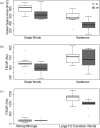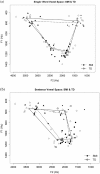Range and Precision of Formant Movement in Pediatric Dysarthria
- PMID: 28655064
- PMCID: PMC5831086
- DOI: 10.1044/2017_JSLHR-S-15-0438
Range and Precision of Formant Movement in Pediatric Dysarthria
Abstract
Purpose: This study aimed to improve understanding of speech characteristics associated with dysarthria in children with cerebral palsy by analyzing segmental and global formant measures in single-word and sentence contexts.
Method: Ten 5-year-old children with cerebral palsy and dysarthria and 10 age-matched, typically developing children participated in this study. Vowel space area and second formant interquartile range were measured from children's elicited productions of single words and sentences.
Results: Results showed that the children with dysarthria had significantly smaller vowel space areas than typically developing children in both word and sentence contexts; however, overall ranges of second formant movement did not differ between groups in word or sentence contexts. Additional analysis of single words revealed that, compared to typical children, children with dysarthria had smaller second formant interquartile ranges in single words with phonetic contexts requiring large changes in vocal tract configuration, but not in single words with monophthongs.
Conclusions: Results of this study suggest that children with dysarthria may not have globally reduced ranges of articulatory movement compared to typically developing peers; however, they do exhibit reduced precision in producing phonetic targets.
Figures




References
-
- Carrow-Woolfolk E. (2014). Test for Auditory Comprehension of Language–Fourth Edition. Austin, TX: Pro-Ed.
-
- Darley F. L., Aronson A. E., & Brown J. R. (1969). Clusters of deviant speech dimensions in the dysarthrias. Journal of Speech and Hearing Disorders, 12, 462–496. - PubMed
-
- De Bodt M. S., Hernandez-Diaz H. M., & Van De Heyning P. H. (2002). Intelligibility as a linear combination of dimensions in dysarthric speech. Journal of Communication Disorders, 35, 283–292. - PubMed
-
- Fant G. (1960). Acoustic theory of speech production. The Hague, the Netherlands: Mouton.
Publication types
MeSH terms
Grants and funding
LinkOut - more resources
Full Text Sources
Other Literature Sources

